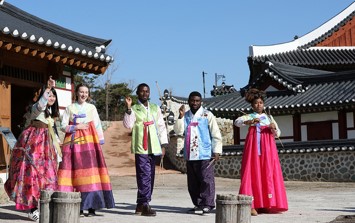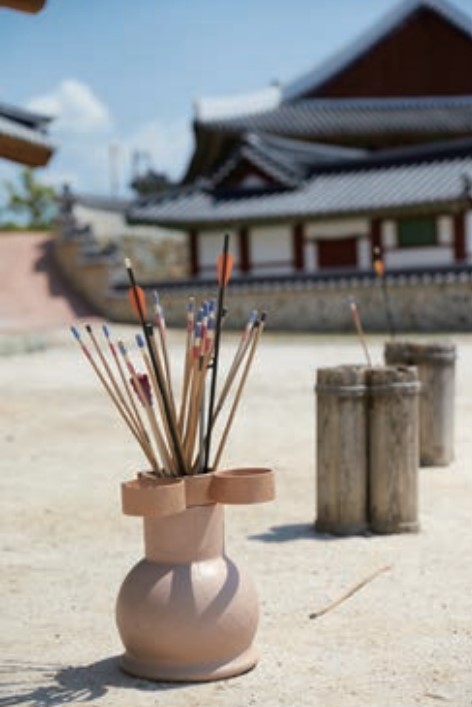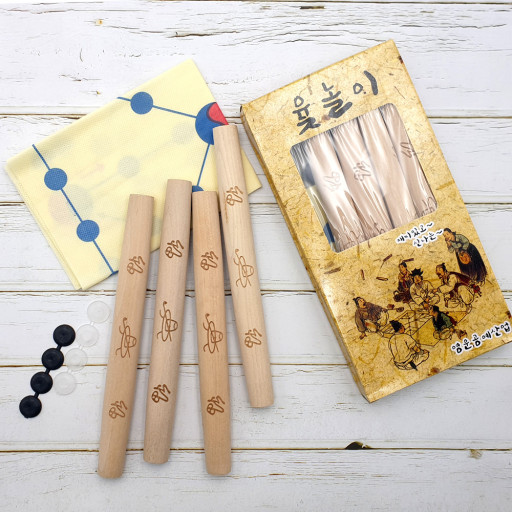
As soon as ”Green Light!“ is called, the people who play the game run toward the tagger and stop there. In other game, participants try hard to stab the needle along the lines of the shapes of an umbrella, star, triangle, and circle to remove them. These are scenes of the Netflix drama, Squid Game. The drama deals with 456 people participating in survival games (mostly traditional Korean games) to win 45.6 billion won in prize money. Squid Game was so popular, not only in Korea, but around the world recording the largest number of viewing households of any other Netflix program. Naturally, traditional Korean games are also attracting attention. Aren’t you curious about more Korean traditional games besides the ones that appeared in the Squid Game? Let’s learn about traditional Korean games as sweet and fun as dalgona with CAH.
1. Yangban[1]’s Game, Tuho

According to The Academy of Korean Studies, “Tuho” is a game in which a bottle is placed at a certain distance, people throw arrows into it, and the number of arrows in the bottle determines the winner. The rules of Tuho are very simple. After dividing the sides, participants throw the same number of arrows towards a bottle at a certain distance. One who puts more arrows in the jar becomes the winner. Tuho was mainly played in courts and aristocratic houses in the past. In particular, courtesy was important to each other because it was a game of yangban, and that the common people of the Joseon Dynasty could not play Tuho because they could not prepare arrows and pots. However, today, anyone can enjoy it because of modern simplifying of the things needed for Tuho and making it easy. Anyone can easily enjoy Tuho by using long grass sticks or wooden chopsticks instead of arrows and paper boxes or trash cans instead of pots. Tuho also has the advantage of increasing concentration, patience, and accuracy as you need to focus to hit arrows on the target.
2. Catch Rocks as Much as You Can, Gonggi Nori
Do you remember the marbles in Squid Game? It is a game using round and transparent glass beads and with diverse play methods. A similar game is "Gonggi Nori." Gonggi Nori is a game played with five or more small and round rocks throwing and holding them with hands. Girls especially enjoy this game. Uniquely, Gonggi Nori has slightly different play rules and different names depending on the region. However, the common way to win is the same: You age as much as the number of rocks you catch, and you win if this age reaches the target age first. The basic methods of Gonggi Nori provided by The Federation of Korean Cultural Center are as follows.

-The Basic Way to Play Gonggi Nori
The play takes place in the order of one's→two's→three's→four's→kkeokgi.
Level 1: Pick up one gonggi (Clasping 1 stone) Throw five gonggi on the floor and scatter them, pick up one of them and throw it up. After that, pick up another the floor and catch the gonggi thrown earlier before it falls on the floor.
Level 2: Pick up two (Clasping 2 stones) Proceed in the same way as before, but pick up two gonggi from the floor.
Level 3: Pick up three (Clasping 3 stones) This time pick up three pieces of gonggi remaining on the floor. After that, pick up the remaining two pieces of gonggi.
Level 4: Pick up four (Clasping 2 stones) Hold all the gonggi in your hand and throw only one ball up. Put the rest of the gonggi on the ground and catch the gonggi. Then throw the gonggi in your hand up again, and grab the four gonggi on the floor at once.
Level 5: KKeokgi (Snapping) Throw five gonggi and catch them on the back of your hand, then toss them again, and catch them in the air.
In addition, since there are various variations in each region, it would be a good idea to learn basic Gonggi Nori and try application movements.
3. Play That Starts with 4 Yut Sticks, Playing Yut Nori

“Yut Nori” is a game that you can often enjoy around Lunar New Year’s Day, and it is a game in which you use pieces to compete around a board according to the results of throwing four yut sticks, like how you would use dice. Remember that X should be marked on the back of one of the four yut sticks. This X indicates that you must go back one space. It is a game that can be played anywhere with four yut sticks, pieces, and a board. Also, variables that appear in the play process give a variety of fun, making it a game that is not only enjoyed around Lunar New Year but can be played anytime, anywhere. The method of playing the Yut Nori provided by the National Folk Museum of Korea is as follows.
When four yuts are thrown to the floor, the distance the piece goes varies through the number of overturned yuts.
A. “Do,” You can move one space if one yut lands flatside up.
b. “Gae,” You can move two spaces if two land flatside up.
c. “Geol,” You can move three spaces if three land flatside up.
d. “Yut,” move 4 spaces if all four land flatside up.
e. “Mo’” if all yuts land flatside side down move 5 spaces.
f. “X(Back),” If the one X yut is turned upside down, go back one space.
The first team to arrive at the end point wins. However, if another team's horse (piece) comes to other team’s horse's position and is caught while moving, that team has to return to the starting point.
In addition to the Tuho Nori, Gonggi Nori, and Yut Nori introduced above, there are many traditional games in Korea where you can feel the wisdom of our ancestors. Traditional Korean games are easy since anyone can enjoy them if they learn just a few rules. It seems this is the reason why the world is interested in traditional Korean games. Why don't you play a fun traditional Korean game with your friends and families?
[1] The aristocrat class during the Goryeo and Joseon periods.

